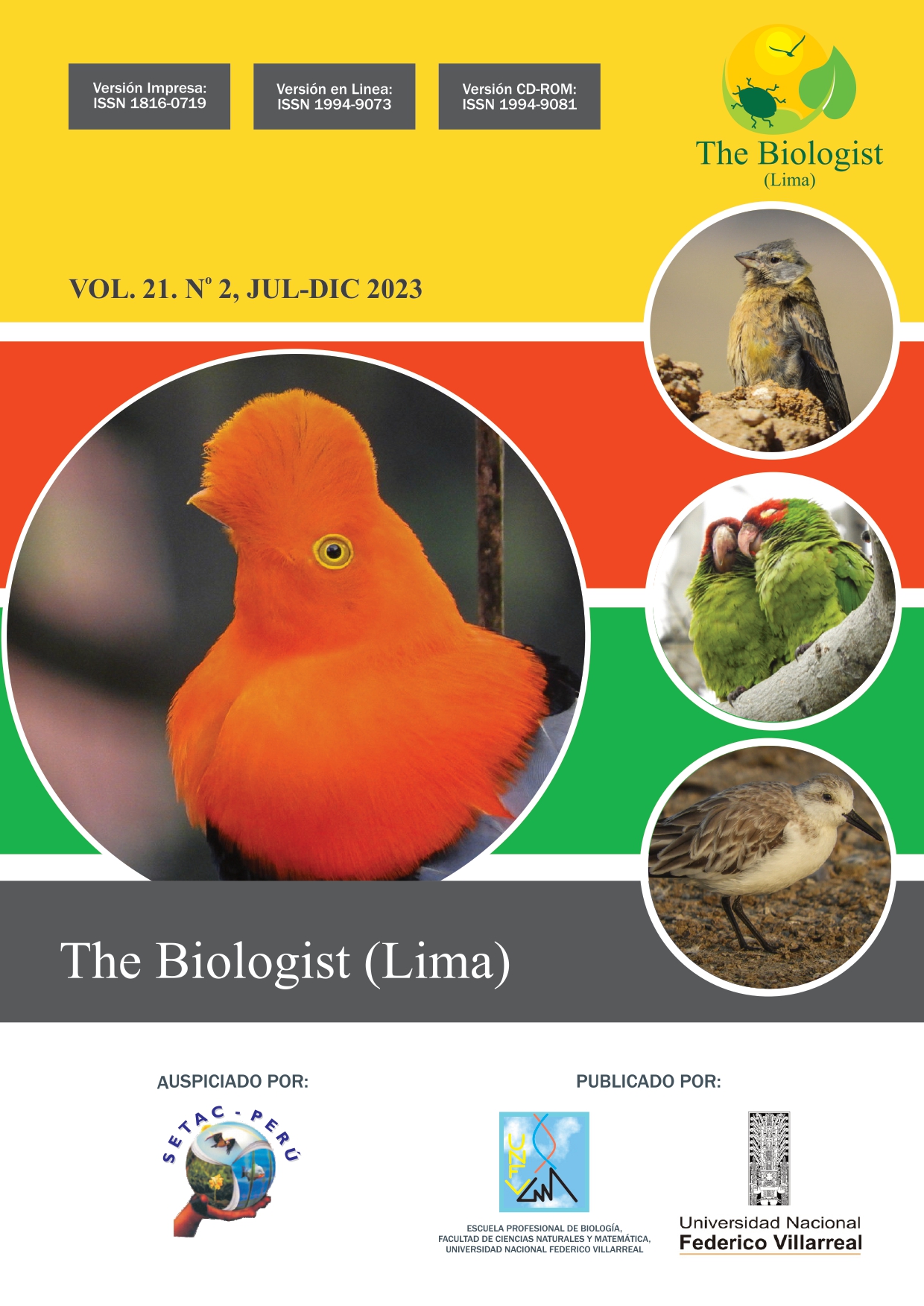Primer registro de Notopygos ornata (Grube, 1856) (Polychaeta: Amphinomidae) en Ecuador continental
DOI:
https://doi.org/10.24039/rtb20232121575Palavras-chave:
Biodiversidad , Intermareal Rocoso , Invertebrados Marinos , Poliquetos bentónicosResumo
Se registra al poliqueto Notopygos ornata (Grube, 1856), por primera vez en Ecuador continental, la especie se distribuye desde el Golfo de California hasta las islas Galápagos. Su identificación se basó en literatura especializada, claves taxonómicas y descripción original. La característica principal de esta especie es su carúncula trilobulada, el complejo patrón de pigmentación que inicia desde el setígero siete en la región dorsal y el ano en posición dorsal en el setígero 24. El presente trabajo confirma que su distribución se extiende en el lado del pacifico por el continente ecuatoriano, se sugiere realizar más investigaciones sobre la poliquetofauna que existe en el país.
Downloads
Referências
Blake, J. (1991). The Polychaete Fauna of the Galápagos Islands. In M. J. James (Ed.), Galápagos Marine Invertebrates: Taxonomy, Biogeography, and Evolution in Darwin’s Islands (pp. 75–96). Springer US.
Borda, E., Kudenov, J. D., Bienhold, C., & Rouse, G. W. (2012). Towards a revised Amphinomidae (Annelida, Amphinomida): description and affinities of a new genus and species from the Nile Deep-sea Fan, Mediterranean Sea. Zoologica Scripta, 41(3), 307–325.
Borda, E., Yáñez-Rivera, B., Ochoa, G. M., Kudenov, J. D., Sanchez-Ortiz, C., Schulze, A., & Rouse, G. W. (2015). Revamping Amphinomidae (Annelida: Amphinomida), with the inclusion of Notopygos. Zoologica Scripta, 44(3), 324–333.
Brusca, R. (1980). Common Intertidal Invertebrates of the Gulf of California. 2nd ed. University of Arizona Press.
Leon-Gonzales, J., Bastidas-Zavala, R., & Salazar-Vallejo, S. (2021). Anelidos marinos de Mexico y America Tropical (primera). Universidad Autonoma Nueva Leon.
Fauchald, K. (1977). The polychaete worms. Definitions and keys to the orders, families and genera. Natural History Museum of Los Angeles County, Science Series.
Grube, A. (1854). Annulata Örstediana. Enumeratio Annulatorum, quae in itinere per Indiam occidentalem et Americam centralem annis 1845-1848 suscepto legit cl. A.S. Örsted, adjectis speciebus nonnullis a cl. H. Kröyero in itinere and Americam meridionalem collectis (Vols. 1854–1856). Kjöbenhavn, Selskabets Bestyrelse, [1849]-1912. https://www.biodiversitylibrary.org/item/110253
Grube, A. (1856). Beschreibung neuer oder wenig bekannter Anneliden. Archiv Für Naturgeschichte, 21, 81–136. https://www.biodiversitylibrary.org/part/13989
Hartman, O. (1940). Polychaetous annelids. Part II. Chrysopetalidae to Goniadidae. Allan Hancock Pacific Expeditions. [Reports], 7(3), 173–287. https://www.biodiversitylibrary.org/item/88616
Hutchings, P. (2000). Family Amphinomidae. Polychaetes & Allies: The Southern Synthesis Fauna of Australia 4a Polychaeta, Myzostomida, Pogonophora, Echiura, Sipuncula. Melbourne: CSIRO Publishing, (pp.107–110).
Kudenov, J. D. (1980). Annelida: polychaeta (bristleworms). Common Intertidal Invertebrates of the Gulf of California, 2, 77–123.
Kudenov, J. D. (1991). A new family and genus of the order Amphinomida (Polychaeta) from the Galapagos hydrothermal vents. Ophelia Supplement, 5, 111–120.
Kudenov, J. D. (1995). Family amphinomidae lamarck, 1818. Taxonomic Atlas of the Benthic Fauna of the Santa Maria Basin and Western Santa Barbara Channel, 5, 207–215.
Steinbeck, J., & Ricketts, E. F. (1941). Sea of Cortez: A leisurely journal of travel and research. Viking Press.
Wiklund, H., Nygren, A., Pleijel, F., & Sundberg, P. (2008). The phylogenetic relationships between Amphinomidae, Archinomidae and Euphrosinidae (Amphinomida: Aciculata: Polychaeta), inferred from molecular data. Journal of the Marine Biological Association of the United Kingdom, 88(3), 509–513.
Yañez-Rivera, B. (2015). Chloeia, eurythoe y notopygos (Polychaeta: Amphinomidae): revisión de las especies registradas en México y aspectos reproductivos [Tesis de doctorado, Universidad Nacional Autónoma de México]. https://repositorio.unam.mx/contenidos/70566
Downloads
Publicado
Como Citar
Edição
Seção
Licença

Este trabalho está licenciado sob uma licença Creative Commons Attribution-NonCommercial-NoDerivatives 4.0 International License.
Objeto: El AUTOR-CEDENTE transfiere de manera TOTAL Y SIN LIMITACIÓN alguna al CESIONARIO (Revista The Biologist (Lima)) los derechos patrimoniales que le corresponden sobre sus obras por el tiempo que establezca la ley internacional. En virtud de lo anterior, se entiende que el CESIONARIO adquiere el derecho de reproducción en todas sus modalidades, incluso para inclusión audiovisual; el derecho de transformación o adaptación, comunicación pública, traducción, distribución y, en general, cualquier tipo de explotación que de las obras se pueda realizar por cualquier medio conocido o por conocer en el territorio nacional o internacional.
Remuneración: La cesión de los derechos patrimoniales de autor que mediante este contrato se hace será a título gratuito.
Condiciones y legitimidad de los derechos: El AUTOR-CEDENTE garantiza que es propietario integral de los derechos de explotación de la(s) obra(s) y en consecuencia garantiza que puede contratar y transferir los derechos aquí cedidos sin ningún tipo de limitación por no tener ningún tipo de gravamen, limitación o disposición. En todo caso, responderá por cualquier reclamo que en materia de derecho de autor se pueda presentar, exonerando de cualquier responsabilidad al CESIONARIO.
Licencia de acceso abierto: El AUTOR-CEDENTE autoriza que manuscrito publicado en la Revista Científica The Biologist (Lima) (versión Impresa ISSN 1816-0719, versión en línea ISSN 1994-9073) permanece disponible para su consulta pública en el sitio web http://revistas.unfv.edu.pe/index.php/rtb/index y en los diferentes sistemas de indexación y bases de datos en las que la revista tiene visibilidad, bajo la licencia Creative Commons, en la modalidad Reconocimiento-No comercial- Sin Trabajos derivados –aprobada en Perú, y por lo tanto son de acceso abierto. De ahí que los autores dan, sin derecho a retribución económica, a la Escuela Profesional de Biología, Facultad de Ciencias Naturales y Matemática de la Universidad Nacional Federico Villarreal (EPB - FCCNM - UNFV), los derechos de autor para la edición y reproducción a través de diferentes medios de difusión.









































